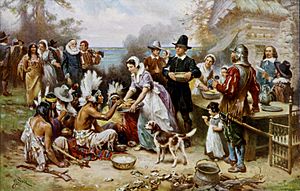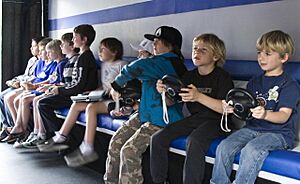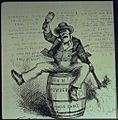Stereotype facts for kids

A stereotype is a simple idea or image that many people have about a group. Think of it as a "label" people sometimes use for everyone in a group. These labels can be about how people act, what they like, how they look, or what they can do.
Sometimes stereotypes can seem positive or neutral. But they often have bad effects. This is because they don't show how unique each person in a group really is. For example, saying "all teenagers love video games" is a stereotype. Many teens do enjoy games, but not all of them. This label doesn't tell you about their other interests or talents. Stereotypes help our brains process info quickly. But they can be wrong and hard to change, even with new facts.
Contents
What Does "Stereotype" Mean?
The word "stereotype" has an interesting past! It comes from the French word "stéréotype." This word is made of two old Greek words:
- "stereos" (στερεός), meaning "firm" or "solid"
- "typos" (τύπος), meaning "impression"
So, it literally means a "solid impression."
The word was first used in 1798 by a French printer named Firmin Didot. He used it for a printing plate. This plate could make exact copies of text. This "stereotype" plate was used instead of the original. It helped make many identical copies.
Later, in 1850, the word "stereotype" started being used in English. It meant an "image kept without change." But the way we use it today, for ideas about people, became popular in 1922. That's when an American journalist named Walter Lippmann used it. He wrote about it in his famous book, "Public Opinion". He talked about how people form fixed ideas about groups.
Two Kinds of Stereotypes
Stereotypes can show up in two main ways:
- Explicit Stereotypes: These are beliefs about a group that a person knows they have. They might even say them out loud. For example, if someone truly believes "all scientists are nerdy," that's an explicit stereotype. People might try to control these beliefs. But it's often hard to be completely fair when you know you have a stereotype.
- Implicit Stereotypes: These beliefs are hidden in a person's mind. People might not even know they have them. They can affect thoughts and actions without conscious control. For example, someone might think boys and girls are equally good at math. But deep down, they might still link math more with boys. These hidden stereotypes come from automatic connections our brains make. They are based on things we've learned or seen over time.
How Do Stereotypes Start?
Stereotypes don't just appear. Different ideas explain how they grow.
Mistaking Behavior for Personality
This happens when people explain someone's actions by their personality. They don't think about the situation the person is in. For example, if you see someone trip, you might think they are clumsy. You might not think the floor was slippery. This way of thinking can lead to stereotypes. If people often see a group in a certain situation, they might wrongly think the group's actions are due to their traits. This forms a stereotype.
Seeing Links That Aren't There
This happens when people wrongly think two things are connected. This is especially true if both things are unusual or stand out. For example, if a small group (which is less common) does something negative (which is also less common), people might wrongly think these two things are strongly linked. This can happen even if they are not. This can lead to unfair stereotypes.
Learning from Others
This is a big reason! We learn stereotypes from the people around us as we grow up. Our parents, teachers, friends, and even media can influence the stereotypes we pick up. Media includes TV shows, movies, and social media. These ideas can be learned at any age. But childhood is a very important time.
Group Interactions
How different groups interact can also shape stereotypes. When groups are in conflict, stereotypes might become more negative. When groups get along better, stereotypes can become more positive. For example, after big events like World War II, people's stereotypes of other countries sometimes changed. It depended on if those countries were allies or enemies.
Artificial Intelligence (AI) and Stereotypes
This is a newer and very important area! Even AI programs can show biases and create stereotypical content. This happens because AI learns from huge amounts of data. If that data has human biases or stereotypes, the AI can learn them and repeat them.
For example, studies in 2024 showed that AI text programs sometimes gave answers that reflected old, unfair ideas about people. This happened even if they gave positive answers when asked directly.
How Stereotypes Affect People
Once a stereotype is active, it can actually change how people act. Sometimes they don't even know it!
For example, one study found that if people saw words about older people (like "Florida"), they later walked more slowly. The words didn't mention slowness directly. This suggests that the stereotype of older people being slow can unconsciously affect behavior.
Self-Fulfilling Prophecy: This is a powerful effect. An expectation based on a stereotype can actually make a person act in a way that proves the stereotype true. If students from a certain group are told their group usually does poorly on a test, they might feel worried. This is called "stereotype threat." This worry can then actually make them do worse. This fulfills the negative expectation.
Stereotypes in Art and Culture
Stereotypes are very common in movies, TV shows, books, and even video games. They are often used to create "stock characters." These are characters that audiences instantly recognize. While this can be a shortcut for storytellers, it also means that media can spread and make stereotypes stronger.
Images for kids
-
Police officers buying doughnuts and coffee. This is an example of a common stereotype in North America.
See also
 In Spanish: Estereotipo para niños
In Spanish: Estereotipo para niños






